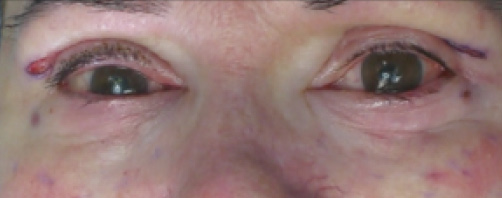Lashing Out: A New Direction in Lash Treatment
Long prominent eyelashes are considered a sign of beauty, and there is little a woman wouldn’t try to make her lashes pop. Eyelash curlers are big business. There are hundreds of versions of these beauty tools available, and women clamp them on to bend their lashes upward before they apply mascara.
This time-consuming grooming ritual can be a big pain point for many patients. Eyelash curlers can even result in lash loss. Fortunately, a new minimally invasive procedure to correct lash ptosis (lashes that point downward) may do away with the need for eyelash curlers for good.
Ideal candidates for this procedure have eyelashes that tilt downward. I use an incisional handpiece with a 200-micron spot to put two rows of staggered spots above the eyelashes to tighten the skin and thus evert the eyelashes. We treat all the way to the base of the eyelashes with the first row and about a millimeter above the lash line for the second row–just above the follicles. This is usually done concurrently with blepharoplasty.
This is a bloodless field. I see the differences on the surgical table between the treated eye and the second eye almost instantly. (Fig. 1) The initial result will fall by 50 percent as the original result is mostly tissue dehydration.

Fig. 1. During blepharoplasty, this patient’s right eye has been treated with the laser lash ptosis repair while the left eye has not yet been treated. One can see the eyelash eversion with laser spots above on the right, while there is remaining lash ptosis on the left.
So far I have completed more than 25 cases, and patient satisfaction is extremely high. There is a very low risk of complications when proper safety precautions are taken. Protecting the eye is paramount, and stainless steel is the only way to go. Jaege Lid plates, Eye Shield, or David Baker Lid Clamps are all good options for eye protection. Patients are anesthetized with local anesthesia. There is a minimal recovery time. In general, patients are told to apply topical antibiotics for about one week. There is moderate edema for the first few weeks, so patients need to be counseled that it may take a few months to see the final result.
We are planning to publish a case series of our experience with this novel procedure in the fall of 2017. This procedure can be an important part of overall eye rejuvenation in the appropriate patient.

Julie Woodward, MD, is Associate Professor of Ophthalmology and Dermatology and Chief of Oculofacial Surgery at Duke University Medical Center in Durham, NC. She originally presented this talk during Cosmetic Surgery Forum 2016 in Las Vegas.
Ready to Claim Your Credits?
You have attempts to pass this post-test. Take your time and review carefully before submitting.
Good luck!






